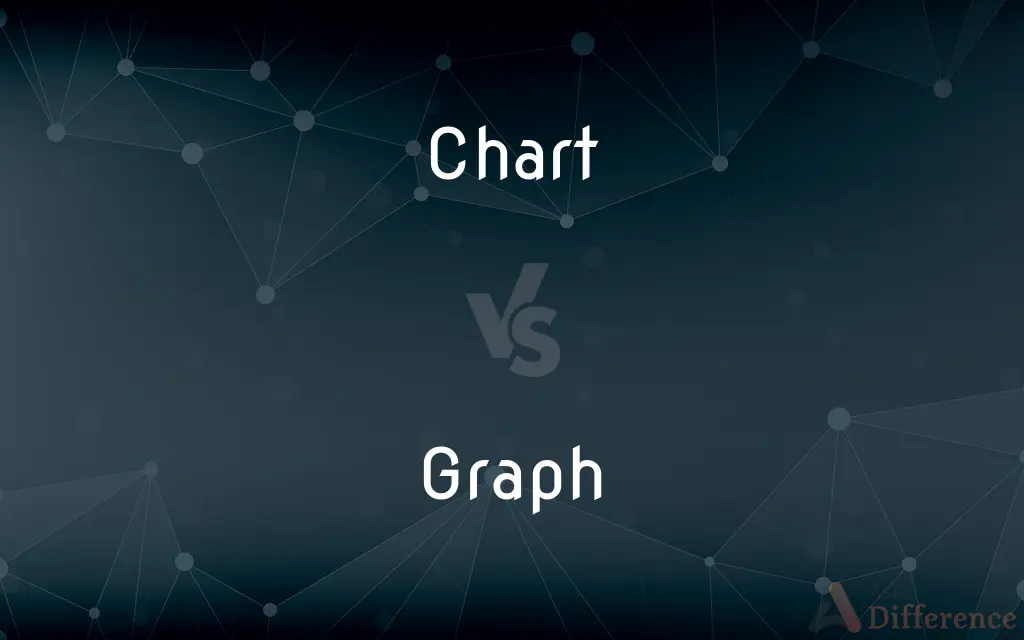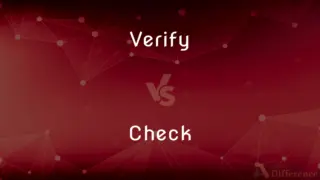Chart vs. Graph — What's the Difference?
By Tayyaba Rehman — Updated on October 27, 2023
A chart is a visual representation of data, often using symbols or diagrams; a graph specifically plots data points on axes. Both display information visually, but with varying formats.

Difference Between Chart and Graph
Table of Contents
ADVERTISEMENT
Key Differences
Chart is a broad term that encompasses various ways of displaying information visually. It can include tables, flow diagrams, and even some types of graphs. On the other hand, a graph is a specific type of chart that represents and plots data points on a set of axes.
Chart often organizes and presents data in a structured manner, which can be both qualitative and quantitative. It might not necessarily show relationships between data points. In contrast, a graph primarily deals with showing relationships between two or more sets of data using points, lines, bars, or curves.
Different types of charts include pie charts, bar charts, and flowcharts, each serving a unique purpose. Graphs, such as line graphs, bar graphs, and scatter plots, emphasize trends, distributions, or correlations in the data.
Chart can be more versatile in terms of design and presentation, allowing for more creative and varied visual representations. Graph, being more specific, adheres to certain formats where data points are plotted against a grid or axis.
While both charts and graphs aid in making data more understandable, the choice between them depends on the nature of the data and the intended message. A graph is often more analytical, whereas a chart can be more descriptive.
ADVERTISEMENT
Comparison Chart
Primary Purpose
Display data visually in various formats.
Plot and represent relationships between data sets on axes.
Data Presentation
Can be qualitative or quantitative.
Primarily quantitative, showing trends or correlations.
Examples
Pie chart, flowchart, table.
Line graph, bar graph, scatter plot.
Design Versatility
More flexible designs and types.
Adheres to specific formats with plotted points.
Relationships
Might not show data relationships.
Emphasizes relationships between data sets.
Compare with Definitions
Chart
A diagrammatic representation of data.
She used a pie chart to represent market share.
Graph
A diagrammatic method to show data distribution.
The bar graph displayed the distribution of survey responses.
Chart
A graphical depiction aiding in understanding complex information.
Using a flow chart, the process was broken down step by step.
Graph
A tool to analyze and interpret data trends.
According to this graph, sales have been increasing.
Chart
A chart is a graphical representation for data visualization, in which "the data is represented by symbols, such as bars in a bar chart, lines in a line chart, or slices in a pie chart". A chart can represent tabular numeric data, functions or some kinds of quality structure and provides different info.
Graph
A visual plot of data points on a coordinate system.
The scatter graph showed a positive correlation between the two variables.
Chart
A sheet of information in the form of a table, graph, or diagram
The doctor recorded her blood pressure on a chart
Graph
A diagram representing relationships between data sets using points on axes.
The graph plotted temperature changes over the year.
Chart
Make a map of (an area)
Cook charted the coasts and waters of New Zealand
Graph
A diagram that exhibits a relationship, often functional, between two sets of numbers as a set of points having coordinates determined by the relationship. Also called plot.
Chart
(of a record) sell enough copies to enter the music charts at a particular position
The record will probably chart at about No. 74
Graph
A pictorial device, such as a pie chart or bar graph, used to illustrate quantitative relationships. Also called chart.
Chart
A map showing coastlines, water depths, or other information of use to navigators.
Graph
The spelling of a word.
Chart
An outline map on which specific information, such as scientific data, can be plotted.
Graph
Any of the possible forms of a grapheme.
Chart
A sheet presenting information in the form of graphs or tables.
Graph
A written character that represents a vowel, consonant, syllable, word, or other expression and that cannot be further analyzed.
Chart
See graph1.
Graph
To represent by a graph.
Chart
Often charts A listing of best-selling recorded music or other items
A hit single that reached number 3 on the charts.
Graph
To plot (a function) on a graph.
Chart
To make a chart of.
Graph
A data chart (graphical representation of data) intended to illustrate the relationship between a set (or sets) of numbers (quantities, measurements or indicative numbers) and a reference set, whose elements are indexed to those of the former set(s) and may or may not be numbers.
Chart
To plan (something) in detail
Is charting a course to destruction.
Graph
(mathematics) A set of points constituting a graphical representation of a real function; (formally) a set of tuples , where for a given function . See also Graph of a function Category:en:Curves Category:en:Functions
Chart
To be ranked on a chart of best-selling items
A song that charted at the number one position last week.
Graph
(graph theory) A set of vertices (or nodes) connected together by edges; (formally) an ordered pair of sets , where the elements of are called vertices or nodes and is a set of pairs (called edges) of elements of . See also Graph (discrete mathematics)
Chart
A map.
Graph
(topology) A topological space which represents some graph (ordered pair of sets) and which is constructed by representing the vertices as points and the edges as copies of the real interval [0,1] (where, for any given edge, 0 and 1 are identified with the points representing the two vertices) and equipping the result with a particular topology called the graph topology.
Chart
A map illustrating the geography of a specific phenomenon.
Graph
A morphism from the domain of to the product of the domain and codomain of , such that the first projection applied to equals the identity of the domain, and the second projection applied to is equal to .
Chart
A navigator's map.
Graph
A graphical unit on the token-level, the abstracted fundamental shape of a character or letter as distinct from its ductus (realization in a particular typeface or handwriting on the instance-level) and as distinct by a grapheme on the type-level by not fundamentally distinguishing meaning.
Chart
A systematic non-narrative presentation of data.
Graph
(transitive) To draw a graph.
Chart
A tabular presentation of data; a table.
Graph
To draw a graph of a function.
Chart
A diagram.
Graph
A curve or surface, the locus of a point whose coördinates are the variables in the equation of the locus; as, a graph of the exponential function.
Chart
A graph.
Graph
A diagram symbolizing a system of interrelations of variable quantities using points represented by spots, or by lines to represent the relations of continuous variables. More than one set of interrelations may be presented on one graph, in which case the spots or lines are typically distinguishable from each other, as by color, shape, thickness, continuity, etc. A diagram in which relationships between variables are represented by other visual means is sometimes called a graph, as in a bar graph, but may also be called a chart.
Chart
A record of a patient's diagnosis, care instructions, and recent history.
I snuck a look at his chart. It doesn't look good.
Graph
A drawing illustrating the relations between certain quantities plotted with reference to a set of axes
Chart
A ranked listing of competitors, as of recorded music.
They're at the top of the charts again this week.
Graph
Represent by means of a graph;
Chart the data
Chart
A written deed; a charter.
Graph
Plot upon a graph
Chart
Synonym of coordinate chart.
Graph
A mathematical representation of data.
The equation's curve was clearly visible on the graph.
Chart
(transitive) To draw a chart or map of.
Chart the seas
Chart
(transitive) To draw or figure out (a route or plan).
Let's chart how we're going to get from here to there.
We are on a course for disaster without having charted it.
Chart
(transitive) To record systematically.
Chart
To appear on a hit-recording chart.
The song has charted for 15 weeks!
The band first charted in 1994.
Chart
A sheet of paper, pasteboard, or the like, on which information is exhibited, esp. when the information is arranged in tabular form; as, an historical chart.
Chart
A map; esp., a hydrographic or marine map; a map on which is projected a portion of water and the land which it surrounds, or by which it is surrounded, intended especially for the use of seamen; as, the United States Coast Survey charts; the English Admiralty charts.
Chart
A written deed; a charter.
Chart
To lay down in a chart; to map; to delineate; as, to chart a coast.
Chart
A visual display of information
Chart
A map designed to assist navigation by air or sea
Chart
Make a chart of;
Chart the territory
Chart
Plan in detail;
Bush is charting a course to destroy Saddam Hussein
Chart
Represent by means of a graph;
Chart the data
Chart
A visual representation of information.
The company displayed a chart showing quarterly profits.
Chart
A structured layout of information.
The seating chart showed where everyone was positioned.
Chart
A visual tool for organizing and presenting data.
Based on this chart, we can see the monthly sales trends.
Common Curiosities
What is a chart?
A visual representation of data or information in various formats.
What is a graph?
A specific type of chart that plots data points on axes to show relationships.
What's an example of a chart?
A pie chart showing percentages of a whole.
How is a chart different from a graph?
A chart can be any visual data representation, while a graph specifically plots data on axes.
Why use a chart?
To visually present data in a structured or organized manner.
What's an example of a graph?
A line graph showing temperature changes over a week.
Are all charts graphs?
No, but all graphs are types of charts.
What are some common types of graphs?
Line graphs, bar graphs, scatter plots, and histograms.
How do graphs help in data analysis?
They visualize trends, correlations, and distributions, making data interpretation clearer.
Can a graph be a chart?
Yes, a graph is a type of chart.
How do I choose between a chart or a graph?
Consider the data's nature, your audience, and the message you want to convey.
Do charts always represent quantitative data?
No, charts can represent both quantitative and qualitative data.
Why use a graph?
To visually represent relationships, trends, or distributions in data.
When should I use a chart and not a graph?
Use a chart for general data visualization and a graph for plotting data relationships.
What are some common types of charts?
Bar charts, pie charts, flowcharts, and tables.
Share Your Discovery

Previous Comparison
Verify vs. Check
Next Comparison
Departure vs. ArrivalAuthor Spotlight
Written by
Tayyaba RehmanTayyaba Rehman is a distinguished writer, currently serving as a primary contributor to askdifference.com. As a researcher in semantics and etymology, Tayyaba's passion for the complexity of languages and their distinctions has found a perfect home on the platform. Tayyaba delves into the intricacies of language, distinguishing between commonly confused words and phrases, thereby providing clarity for readers worldwide.














































